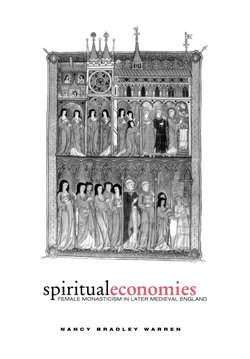Spiritual Economies

Реклама. ООО «ЛитРес», ИНН: 7719571260.
Оглавление
Nancy Bradley Warren. Spiritual Economies
Отрывок из книги
Spiritual Economies
Ruth Mazo Karras, Series Editor Edward Peters, Founding Editor
.....
Tellingly, references to excess familiae appear more frequently in visitations of female houses. Familiae are mentioned in seventeen cases in A. Hamilton Thompson’s three volumes of fifteenth-century visitations of religious houses from the diocese of Lincoln. Five references to familiae occur in visitations of male communities (see above), while twelve occur in visitations of female houses: the Cistercian house of Catesby,105 the Benedictine house of Elstow (two different visitations),106 the Benedictine house of Godstow (two different visitations),107 the Cistercian house of Gokewell,108 the Austin house of Gracedieu,109 the Benedictine house of Langley,110 the Cistercian house of Nuncoton,111 the Benedictine house of Stainfield,112 the Benedictine house of St. Michael’s Stamford,113 and the Cistercian house of Stixwould.114 This difference might mean that excess familiae were in fact more common in female communities, a possibility given nuns’ greater reliance on gifts, annuities and the like.115 It might well mean, though, that visitors were more concerned with familiae and their implications in female houses.
That visitors go further in restricting familiae in female communities than in male communities suggests that ecclesiastical unease with the material autonomy which familiae enabled for nuns did lead to heightened concern about the proliferation of households. For example, rather than insisting on a return to the traditional three familiae, in 1440 Bishop Alnwick restricts the Benedictine nuns of St. Michael’s Stamford to a single familia, requiring them to “stande alle holy wythe the prioresse in hire householde.”116 Alnwick similarly enjoins that the Benedictine nuns at Godstow abandon their diverse familiae in favor of dining all together. He additionally requires that the abbess of this house “do mynystre to thaym of the commune godes of the house mete and drynke owte [of] one selare and one kychyn.”117 This last injunction clearly reveals ecclesiastical desires to restrain the more individual administration of resources that occurred in female houses with numerous familiae. The point was not so much to promote the nuns’ spirituality by encouraging them to live a communal life as to limit the need of the brides of Christ to engage in financial decision making in the commercial marketplace, activity which was perceived as posing such a risk to their valuable purity.
.....